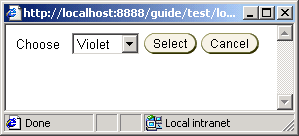
The messageLovField component is a combination of the messageLayout component and the lovField component .
Use the messageLovField component to insert a standard text input field with an associated LOV (flashlight) button for launching a List of Values (LOV) window. A prompt and optional message type icon are placed before the text field. The inline message is placed below the text field. To add a component after the LOV button, use the end named child.

In addition to the general and message attributes, you can also set the primaryClientAction attribute to fire an event when the text in the text input field changes.
When the user clicks the LOV button, an LOV window opens, enabling the user to select a value. For example, the following illustration shows an LOV window containing a dropdown box of choices with two buttons, Select and Cancel. After a selection is made, the LOV window closes and the selected value is populated in the text input field.

For the messageLovField component to work properly, you must provide the code for launching the LOV, and handle the returned result. You can do this either through a JavaScript pseudo URL on the destination attribute or through a JavaScript onClick handler. Any onClick handler, destination URL, or short description that is attached to the messageLovField component is applied to the associated LOV button.
The messageLovField component is similar to the messageLovInput component, but the messageLovField component does not support partial page rendering, field level validation, and a multi-select LOV table. Also, the destination attribute of messageLovInput points to the page containing a listOfValues component (which builds the content of the LOV), and you don't have to write the code for transferring data from the LOV window back to the text input field.
For information about creating an LOV using lovInput, listOfValues, and lovOpenWindowAction, see the ADF UIX Developer's Guide.
About MessageLayout
About Message Form Components and Attributes
Inserting a MessageLovField
Working with Form Components
Copyright © 1997, 2004, Oracle. All rights reserved.